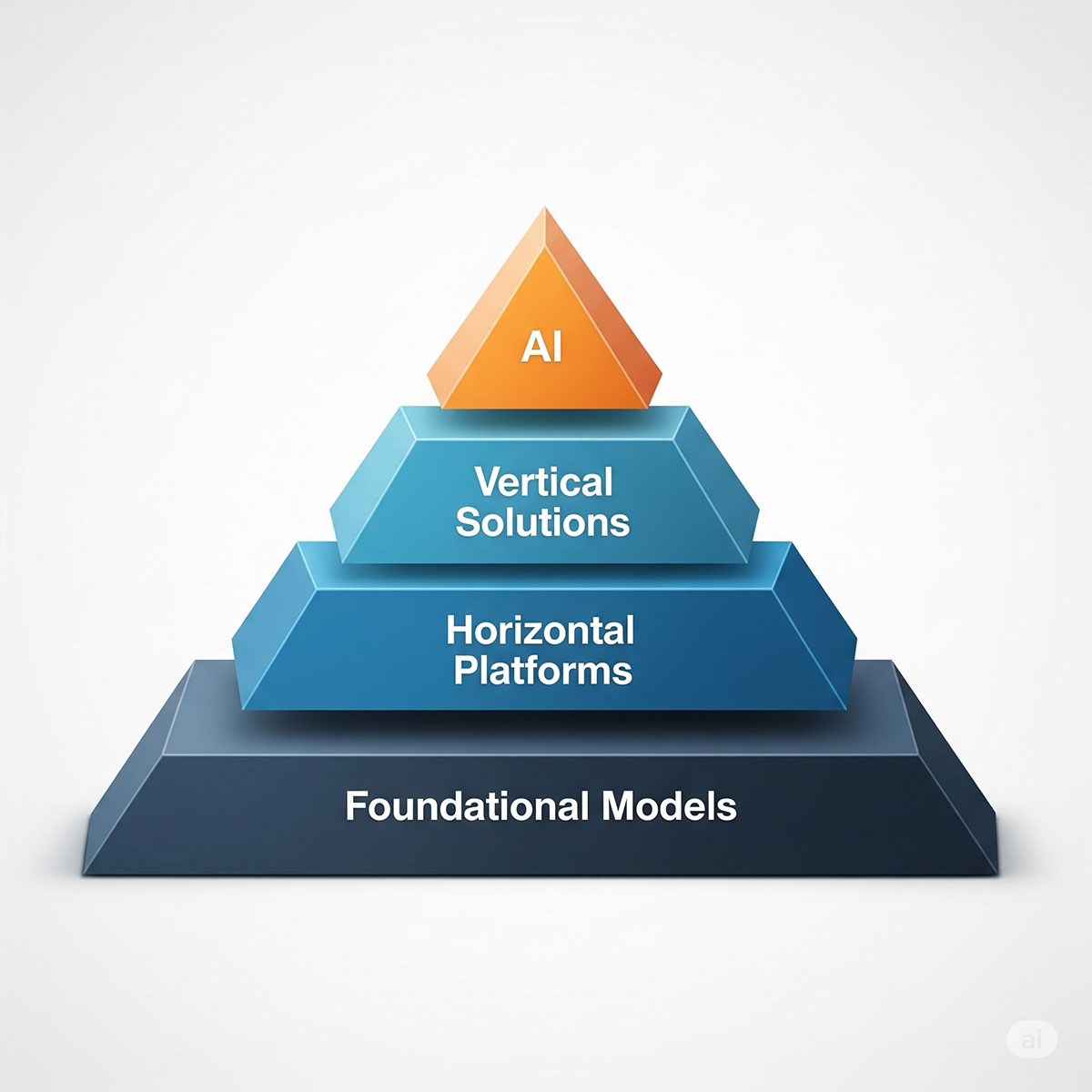Making Sense of the AI Toolbox
Imagine walking into a vast, futuristic workshop. You see giant, humming power generators, workbenches covered in all-purpose tools like drills and wrenches, and specialized kits for intricate tasks like watchmaking or surgery. The world of AI tools is much the same. Not all AI is created equal; different tools are built for very different jobs.
In 2025, the AI landscape has matured from a chaotic collection of experiments into a more organized, layered structure. Let's break down the main categories to understand where each tool fits.
Layer 1: The Power Plants (Foundational Models)
At the very bottom layer, we have the "engines" or the "brains" of the AI world. These are the enormous, general-purpose AI systems that provide the core intelligence for everything else. Think of them as giant power plants generating the electricity that millions of homes and businesses will use.
Crucially, there are different *types* of these power plants. Some are built to understand and generate language (these are Large Language Models, or LLMs, like OpenAI's ChatGPT, Google's Gemini, Anthropic's Claude, Meta's Llama and xAI's Grok). Others are built specifically to create images. These are often Diffusion Models, the technology that powers OpenAI's DALL-E and is believed to be the core of Midjourney's proprietary system.
Layer 2: The Swiss Army Knives (Horizontal Platforms)
This is the layer most of us interact with daily. These are general-purpose applications that take the power from the foundational models and channel it into tools that anyone, in any industry, can use. They are the "Swiss Army Knives" of AI.
- Content Creation: Tools that use foundational models to write emails (using an LLM), generate images for a presentation (using a Diffusion Model), or even create music for a video (e.g., ChatGPT, Midjourney, Suno).
- Productivity & Automation: Tools that help you organize your notes, manage projects, or transcribe your meetings (e.g., Notion AI, Otter.ai).
Layer 3: The Expert Surgeons (Vertical Solutions)
This is one of the fastest-growing areas. These tools are not generalists; they are highly trained specialists. If a horizontal tool is your family doctor, a vertical tool is the expert heart surgeon. They are designed for the unique needs and data of a specific industry, making them incredibly accurate and useful for professionals.
- For Lawyers: AI that is trained on legal documents to help with contract review (e.g., Harvey).
- For Marketers: AI that analyzes data to create content optimized to rank high on Google (e.g., Surfer SEO).
- For Sales Teams: AI that sifts through data to find and qualify potential customers (e.g., Clay).
- For Entire Companies: AI that can answer questions about your company's internal documents, policies, and procedures (our very own Jon AI Company-wide AI).
Concept Spotlight: How AI Creates Images
You might wonder how an AI can create a picture of "an astronaut riding a horse on Mars" from just a sentence. It doesn't "draw" like a human. Most modern image generators use a process called diffusion.
Imagine the process like a sculptor starting with a fuzzy, meaningless block of static—like an old TV screen with no signal.
- The AI starts with a screen full of random noise.
- It has been trained on billions of images, so it has a mathematical understanding of what "astronaut," "horse," and "Mars" look like.
- Guided by your text prompt, the AI begins to refine the noise, step-by-step. In each step, it asks, "Does this look a little more like 'an astronaut on a horse'?" and makes tiny adjustments.
- Over hundreds of these tiny steps, a clear and detailed image slowly "diffuses" out of the static, just as a photograph develops in a darkroom.
This is the core idea behind leading image generators like DALL-E and Stable Diffusion, and it's the technology that experts believe powers the highly artistic outputs of Midjourney.
Comparing the Titans of AI Image Generation
While many tools can create images, the leading platforms have different strengths and approaches.
| Feature | Midjourney | DALL-E (OpenAI) | Stable Diffusion (Stability AI) |
|---|---|---|---|
| Model Type | Proprietary, likely diffusion | Diffusion | Diffusion |
| Access | Discord (subscription) | Web/API | Open source, various UIs |
| Customizability | Limited (closed-source) | Limited | High (open-source) |
| Photorealism | Good, but known for artistry | Good | Good |
Visual Aid: The Layers of AI Tools
We can visualize these categories as a pyramid. The broad, powerful foundational models form the base, supporting the widely used horizontal platforms, which in turn enable the highly specialized vertical solutions at the top.

Vocabulary Builder: The Language of AI Tools
- Foundational Model
- A large-scale AI system that provides core intelligence. This includes different types, like Large Language Models (LLMs) for text and Diffusion Models for images.
- Horizontal Platform
- A general-purpose AI tool designed for a wide range of common tasks across many industries, like writing or image generation. It's the "Swiss Army Knife."
- Vertical Solution
- An AI tool designed and fine-tuned for the specific needs and data of a particular industry, like law or medicine. It's the "Expert Specialist."
Quick Check
An AI tool designed specifically to help doctors analyze medical images would be an example of which category?
Recap: Main categories of online AI tools
What we covered:
- That AI tools are not all the same and can be grouped into categories.
- Foundational Models: The core "engines" that power other AI, including different types for text (LLMs) and images (Diffusion Models).
- Horizontal Platforms: The "everyday" tools for common tasks (e.g., AI writers, image generators).
- Vertical Solutions: The "specialist" tools built for a specific industry (e.g., AI for law or marketing).
Why it matters:
- Understanding these categories helps you make sense of the thousands of AI tools available and choose the right one for your specific needs.
Next up:
- We'll take a closer look at the top AI tools in 2025 and see who the leaders are in each category.



